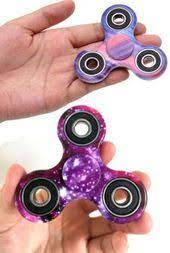(Image courtesy of Pinterest)
Do you remember fidget spinners? And how they got so big that schools were banning them? 2017 seems so long ago, but those little spinners went off to pave the way for more fidget toy trends.
It’s a strange thing to mention in a discussion about mental health, but it’s important.
This is also part of a discussion about mental health, and how the internet exploits it and limits resources, I.E. fidget toys. Which you can read here.
Something to understand: Fidget spinners were made by a guy named Scott McCoskery in 2013, oftentimes marketed as a device to assist those with ADHD (Attention Deficit Hyperactivity Disorder) and those with Autism.
While there isn’t much sustaining evidence that giving kids fidget toys helped them with everything they do in the classroom, giving kids (especially those with ADHD) the ability to fidget helped them in more ways than one.
That was, until classroom environments and teachers came into the picture.
Fidget toys often get taken by teachers from students, even if they need them, sometimes even banning them entirely and groups advocating for a school-wide ban in American schools. That was the case with the fidget spinner, and it’s happened with other fidget toys as well.
“The fidget items most therapists recommend can be used without looking and don’t attract other people’s attention too much with motion or noise. Fidget-spinner motion distracted other kids in classrooms.” The Conversation says. “Popping toys don’t have movement that attracts others’ eyes, but they do make some noise. Kids in our study reported that noise was a reason they got fidget toys taken away in class.”
The popping toys in questions refer to the late 2019 to 2020’s biggest toy trend, the pop-it.
They refer to brightly colored trays of silicone with bubbles in each row, almost like an infinite strip of bubble wrap you can use over and over again.
They became popular over the COVID-19 pandemic, with everyone stuck inside and needing a stress reliever. The only catch was that they became popular with a different audience.
Over on TikTok, a trend started to grow where people would trade fidget toys with others. Pop-its being a common one, with them being mass-produced into different shapes being easy to make and buy, but also unique to a “collector” who wanted them in different shapes.
Another catch was that the people who commonly were making pop-it content and the trades, weren’t for the intended audience of people with mental conditions.
This isn’t to say that people without mental conditions can’t use them, but outside looking in, it just seemed like the pop-it was just another trend for people to cash into.
Even with the various news reports reporting on the banning of fidget toys, all the people who report on them make no acknowledgement on their intended uses, they just see something popular with kids without any further research, especially for those with conditions like ADHD, a focusing disorder. They just see the popularity in neurotypical children.
Something to consider: Do these trends with these fidget toys hinder resources for neurodiverse children?
Well, there are scarce sources on whether these toys really benefit children with Autism and ADHD, despite these toys being marketed as such.
The only seeming study about it is from Taylor and Francis Online, who documented children with ADHD and if they perform better in classroom settings when they were able to squirm and fidget. This is what the study details:
“The current study included 44 children between the ages of 10 and 17 diagnosed with ADHD or who were typically developing (TD), all of whom had no psychiatric co-morbidity or significant learning disorders.”
“Analyses assessed the relationship between frequency and intensity of activity to task accuracy on a trial-by-trial basis. A significant interaction effect between group and performance revealed that more intense movement was associated with better performance in the ADHD group but not in the TD group. The ADHD group demonstrated more intense activity than the TD group during correct (but not error) trials. Within-group, children with ADHD generated higher intensity movements in their correct trials compared to their error trials, whereas the TD group did not demonstrate any within-group differences.”
To summarize, there is some benefit surrounding letting kids with ADHD fidget.
However, nothing concrete for the toys. That doesn’t mean they don’t help kids. If anything, the news-wide coverage about them got them more exposure, and it showcases that these are helping them in some capacity.
There is a gray area in letting these get popular. They get exposed to a wide audience of kids who could get some benefit out of it, but there’s also people who buy them in bulk and use them in trends to trade with others on TikTok.



